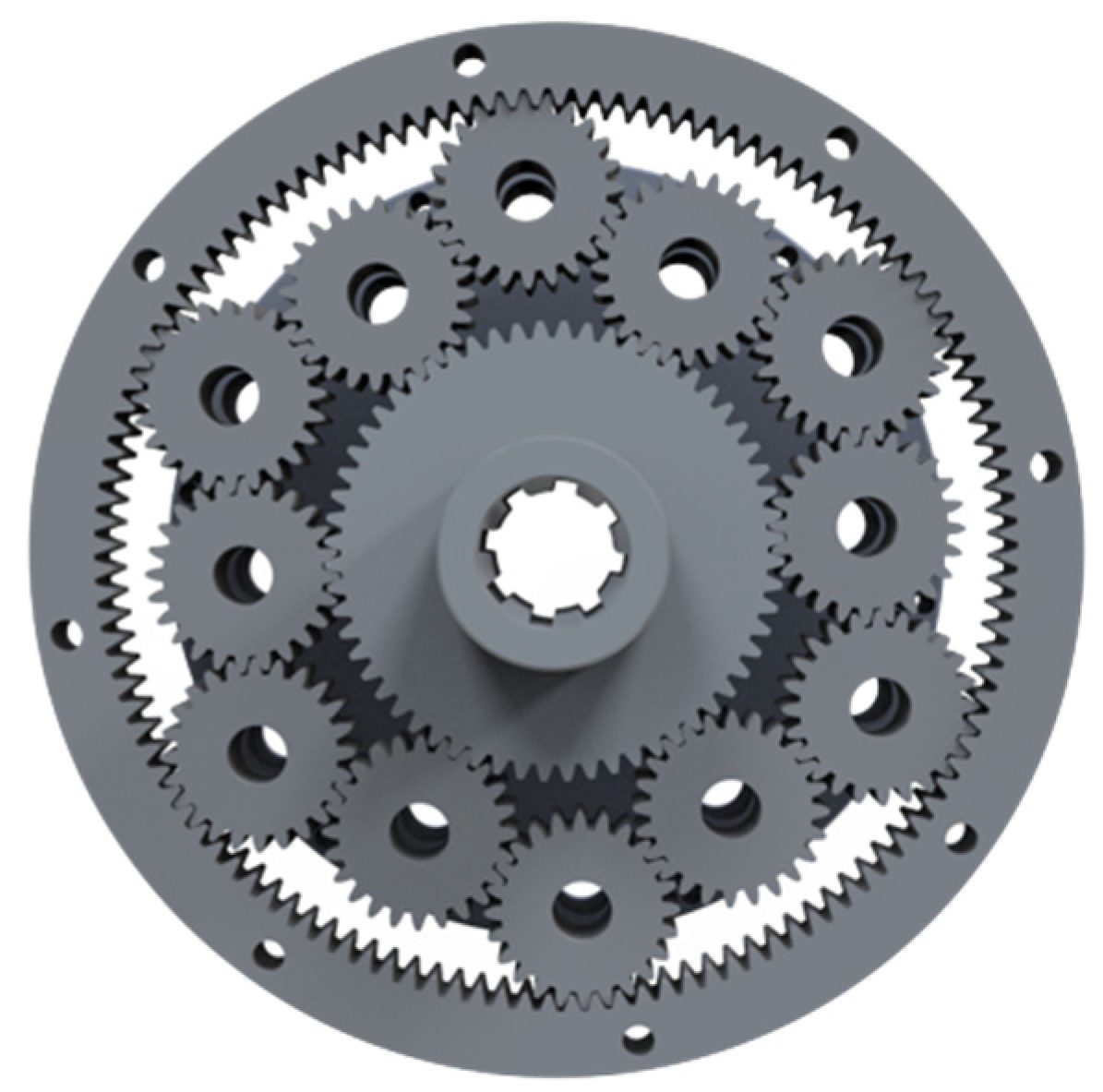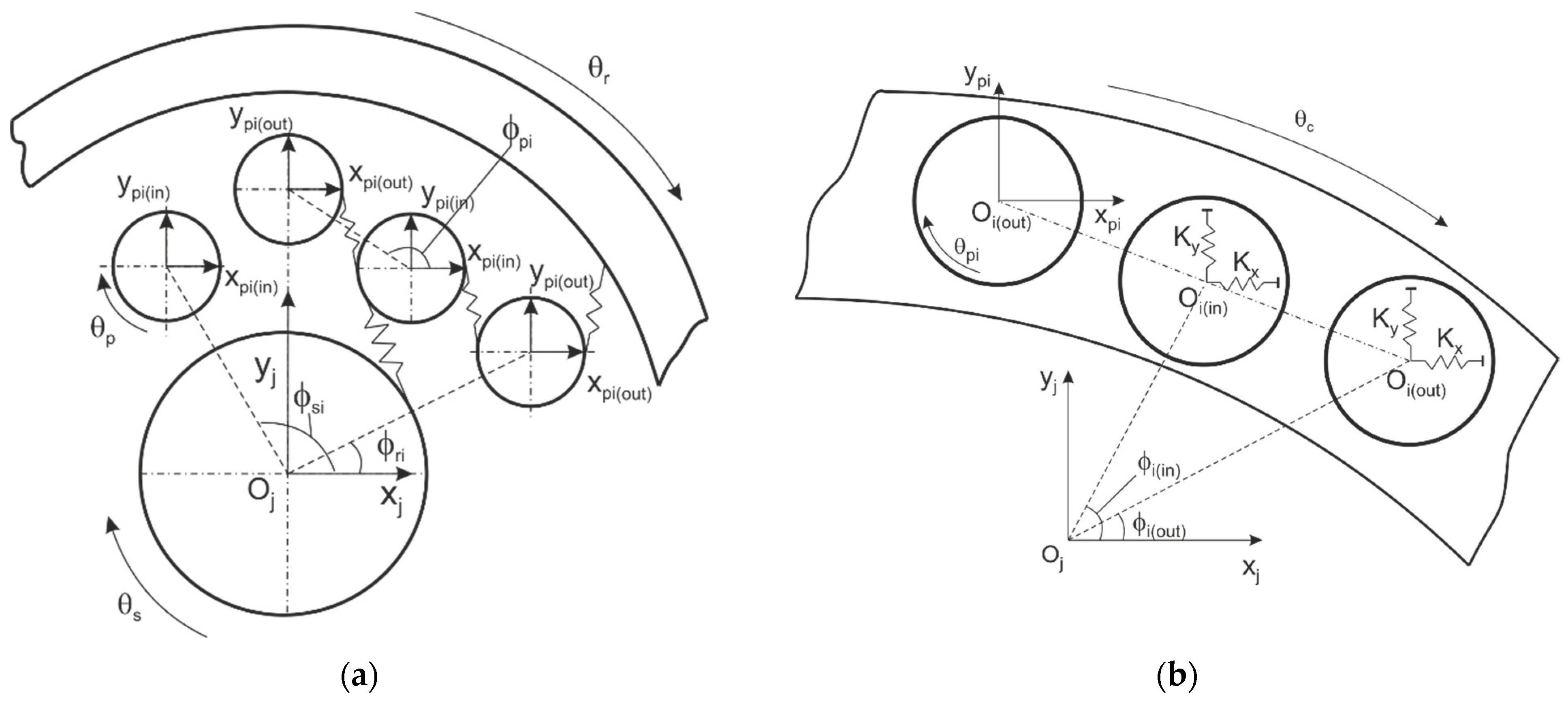Static Load Sharing Analysis of a Full Pinion Engagement Planetary Gear Train Based on Statistical Simulation †
Abstract
1. Introduction
2. A lumped Mass Model of a Full Pinion Engagement Planetary Gear Train
2.1. Main Assumptions
- Since the model will be used for static load sharing analysis, the damping effect will be neglected;
- All components of the gear train will be considered as being rigid except for the tooth mesh and the bearings, which will be modeled as lumped linear springs;
- The tooth mesh stiffness will be considered to be time-invariant;
- The frictional forces acting in the gear meshing will be neglected;
- The random pinhole tangential and radial position errors will be considered and included in the force vector of the model. The rest of the manufacturing and assembly errors will be neglected;
- The system will have three degrees of freedom—translation in x and y directions and rotation ϴj (j = s, r, p, c).
2.2. Building the Model
3. The Monte Carlo Simulation
3.1. Normal Distribution of a Random Variable
3.2. A Parametric Study of the Influence of Random Pinhole Position Errors on the Static Load Sharing
- Mesh stiffness: Kspi = Krpi = Kppi = 5.2 × 108 N/m;
- Support stiffness: Kx = Ky = 5.0 × 108 N/m, Kcu = 1 × 1012 Nm/rad, Ksu = Kru = 1 × 10−9 Nm/rad;
- Transverse pressure angle: αs = αr = αpp = 200.
3.3. Simulation Results
4. Conclusions
Author Contributions
Funding
Institutional Review Board Statement
Informed Consent Statement
Data Availability Statement
Acknowledgments
Conflicts of Interest
References
- Arnaudov, K.; Karaivanov, D. Planetary Gear Trains; Taylor & Francis Group, LLC: Milton Park, UK, 2019. [Google Scholar]
- Arnaudov, K.; Karaivanov, D.; Dimitrov, L. Some practical problems of distribution and equalization of internal loads in planetary gear trains. Mech. Mach. Sci. 2013, 13, 585–596. [Google Scholar]
- Bodas, A.; Kahraman, A. Influence of carrier and gear manufacturing errors on the static load sharing behavior of planetary gear sets. JSME Int. J. Ser. C 2004, 47, 908–915. [Google Scholar] [CrossRef]
- Tsai, S.-J.; Hwang, G.-L.; Yeh, S.-Y. An Analytical Approach for Load Sharing Analysis of Planetary Gear Drives. In Proceedings of the 13th World Congress in Mechanism and Machine Science, Guanajuato, Mexico, 19–25 June 2011. [Google Scholar]
- Kahraman, A. Load Sharing Characteristics of Planetary Transmissions. Mech. Mach. Theory 1994, 29, 1151–1165. [Google Scholar] [CrossRef]
- Inalpolat, M.; Kahraman, A. A dynamic model to predict modulation sidebands of a planetary gear sets having manufacturing errors. J. Sound Vib. 2010, 329, 371–393. [Google Scholar] [CrossRef]
- Liu, W.; Li, J.; Kang, Y.; Liu, Y.; Xu, X.; Dong, P. Load Sharing Behavior of Double-Pinion Planetary Gear Sets Considering Manufacturing Errors. IMMAEE 2019. In Proceedings of the IOP Conf. Series: Materials Science and Engineering, Kazimierz Dolny, Poland, 21–23 November 2019; Volume 677. [Google Scholar]
- Wei, J.; Zhang, A.; Qin, D.; Lim, T.; Shu, R.; Lin, X.; Meng, F. A coupling dynamics analysis method for a multistage planetary gear system. Mech. Mach. Theory 2016, 110, 27–49. [Google Scholar] [CrossRef]
- Singh, A. Epicyclic load sharing map—Application as a design tool. In Proceedings of the American Gear Manufacturers Association Fall Technical Meeting, Cincinnati, OH, USA, 30 October–1 November 2011; pp. 55–79. [Google Scholar]
- Zhang, J.; Guo, F. Statistical modification analysis of helical planetary gears based on response surface method and Monte Carlo simulation. Chin. J. Mech. Eng. 2015, 28, 1194–1203. [Google Scholar] [CrossRef]
- Diez-Ibarbia, A.; Sanchez-Espiga, J.; Fernandez-del-Rincon, A.; Calvo-Irisarri, J.; Iglesias, M.; Viadero, F. Probabilistic analysis of the mesh load factor in wind-turbine planetary transmissions: Tooth thickness errors. Mech. Mach. Theory 2023, 185, 105341. [Google Scholar] [CrossRef]
- Alexandrov, A.; Ivanov, V. The influence of planet position on axle loads in double planet planetary gear trains. Eng. Proc. 2023, 41, 3. [Google Scholar]
- ISO 6336-1:2019; Calculation of Load Capacity of Spur and Helical Gears. Basic Principles, Introduction and General Influence Factors. International Organization for Standardization: Geneva, Switzerland, 2006.
- Ivanov, V.; Aleksandrov, A.; Tsonev, V.; Kuzmanov, N.; Troha, S.; Dimitrov, L. The effect of external forces on the load sharing of a full planet engagement planetary gear train. In Proceedings of the 2022 International Conference on Communications, Information, Electronic and Energy Systems (CIEES 2022), Veliko Tarnovo, Bulgaria, 24–26 November 2022. [Google Scholar]
- ANSI/AGMA 6123-B06; Design Manual for Enclosed Epicyclic Gear Drives. American Gear Manufacturers Association: Alexandria, Virginia, 2016.
- IEC 61400-4:2012; Design Requirements for Wind Turbine Gearboxes. International Electrotechnical Commission: Geneva, Switzerland, 2012.



| Scenario Number | Mathematical Expectation a [mm] | Standard Deviation σ [mm] |
|---|---|---|
| 1 | 0 | 0.010 |
| 2 | 0 | 0.005 |
| 3 | 0 | 0.003 |
| 4 | 0.020 | 0.007 |
| 5 | 0.015 | 0.005 |
| 6 | 0.010 | 0.003 |
| 7 | −0.020 | 0.007 |
| 8 | −0.015 | 0.005 |
| 9 | −0.010 | 0.003 |
| Scenario Number | LSFin max [%] | LSFout max [%] | Kγ |
|---|---|---|---|
| 1 | 18.0 | 21.5 | 3.50 |
| 2 | 17.7 | 21.5 | 3.50 |
| 3 | 18.0 | 21.0 | 3.50 |
| 4 | 8.0 | 12.9 | 1.75 |
| 5 | 8.3 | 13.1 | 1.80 |
| 6 | 8.5 | 13.2 | 1.84 |
| 7 | 8.4 | 12.6 | 1.77 |
| 8 | 8.6 | 12.9 | 1.82 |
| 9 | 8.8 | 13.0 | 1.86 |
Disclaimer/Publisher’s Note: The statements, opinions and data contained in all publications are solely those of the individual author(s) and contributor(s) and not of MDPI and/or the editor(s). MDPI and/or the editor(s) disclaim responsibility for any injury to people or property resulting from any ideas, methods, instructions or products referred to in the content. |
© 2024 by the authors. Licensee MDPI, Basel, Switzerland. This article is an open access article distributed under the terms and conditions of the Creative Commons Attribution (CC BY) license (https://creativecommons.org/licenses/by/4.0/).
Share and Cite
Ivanov, V.; Tzenova, Z. Static Load Sharing Analysis of a Full Pinion Engagement Planetary Gear Train Based on Statistical Simulation. Eng. Proc. 2024, 60, 3. https://doi.org/10.3390/engproc2024060003
Ivanov V, Tzenova Z. Static Load Sharing Analysis of a Full Pinion Engagement Planetary Gear Train Based on Statistical Simulation. Engineering Proceedings. 2024; 60(1):3. https://doi.org/10.3390/engproc2024060003
Chicago/Turabian StyleIvanov, Vladislav, and Zlatina Tzenova. 2024. "Static Load Sharing Analysis of a Full Pinion Engagement Planetary Gear Train Based on Statistical Simulation" Engineering Proceedings 60, no. 1: 3. https://doi.org/10.3390/engproc2024060003
APA StyleIvanov, V., & Tzenova, Z. (2024). Static Load Sharing Analysis of a Full Pinion Engagement Planetary Gear Train Based on Statistical Simulation. Engineering Proceedings, 60(1), 3. https://doi.org/10.3390/engproc2024060003






